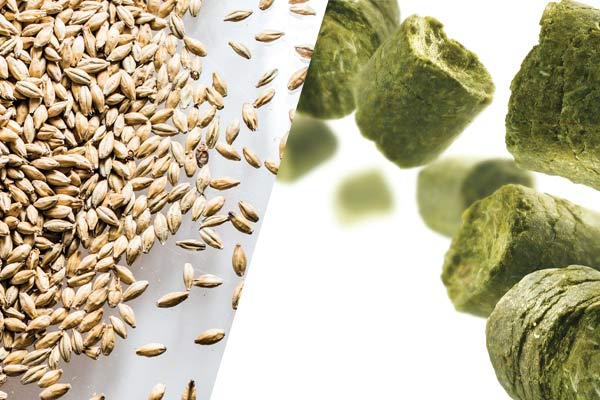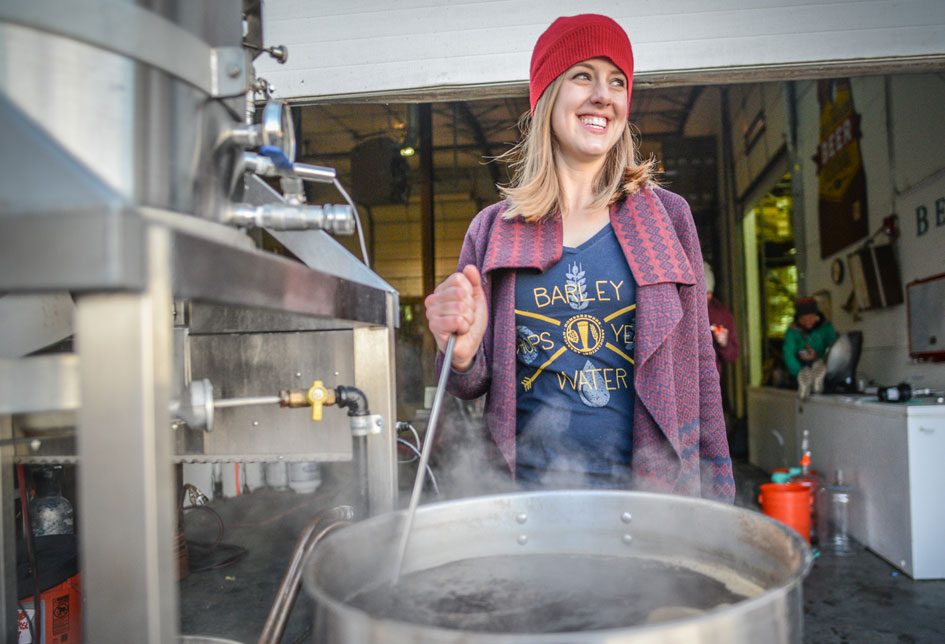

This article originally appeared in the November/December 2023 issue of Zymurgy Magazine
By Dan Jablow
Log in to access the full article from the November/December 2023 Zymurgy magazine, including the Super SMaSH Bros. homebrew recipe!
Whether you are an experienced homebrewer or just getting started on your brewing adventure, chances are you’ve brewed a SMaSH beer at some point, and probably haven’t given it much thought. Compared to a brew with a more complex grain bill and hop schedule, such as an oatmeal stout or hazy IPA, it can be easy to overlook the beautiful simplicity that lies in a beer made from only one kind of grain and one hop variety (Single Malt and Single Hop). It doesn’t represent a specific style as much as a blueprint, or starting point that truly embodies a “less is more” approach, and therein lies its beauty.
Last year, I wrote an article for Zymurgy on brewing beer in single-gallon batches (“Small-Batch Brewing,” Jan/Feb 2023). In that article, I discussed the logic behind that approach, described the equipment needed, and included an all-grain recipe perfectly suited for a first-time or relatively new brewer. It just so happened that this recipe was for a SMaSH ale.
While that article was written with the novice homebrewer in mind, experienced homebrewers can also find value in small-batch brewing. Brewing small batches of SMaSH beers can unlock tons of brewing potential. In my early days of homebrewing, this practice aided my growth and development as a brewer by allowing me to fine-tune my systems and figure out how best to approach recipe development. This article represents the second part of my small-batch journey.
The simplicity of SMaSH brewing allows for a greater understanding of how each ingredient contributes to the overall character of the beer. While I’d argue that a single-gallon size is perfect for SMaSH trials, there’s no hard and fast rule that says SMaSH beers can only be brewed one gallon at a time. So, let’s dive in here and learn all we can about using this format to unlock our brewing potential.
When I first started homebrewing, I brewed exclusively from recipe kits that were prepackaged with the correct amount of hops, yeast, and milled grain (grist) required to make single-gallon batches. No extract here—I started with all-grain brewing and have only brewed a handful of extract-based kits to satisfy my own curiosity. As a beginner, whether you’re an all-grain or extract brewer, brewing from kits is a fantastic way to get started. Kits offer a fairly risk-free way to get your brewing reps in and are offered in a wide variety of styles. The same goes for adopting recipes other brewers have created. These recipes can be found across numerous platforms—books, magazines, YouTube, Facebook. The list goes on and on.
As a formally trained chef who ran a smoked meats and catering business using recipes of my own design, I knew that it was only a matter of time until I’d be ready to try my hand at creating my own beer recipes. At the very beginning, I wasn’t sure where and how to start. It was in Mike Karnowski’s Homebrew Beyond the Basics, a fantastic and seemingly overlooked homebrewing book, where I first heard the term SMaSH and was intrigued. Could it really be this simple to create a custom brew by following this blueprint?
My early brews served to calibrate my stovetop brewing system, determining among other things what equipment I really needed on brew and packaging days, how to control temperature, and how to avoid boil-overs (I speak from experience here). Sometimes I even brewed the same recipe kit multiple times just to see if I was able to achieve the same results consistently. As I became intimately familiar with my brewing system over these initial ten or so brews, I was ready to take another step forward by creating my own recipe from scratch. Enter the SMaSH ale…
In developing my first custom brew recipe, I knew that I’d need to first answer an important question: how much grist would I need for a single-gallon batch? I scoured my collection of homebrewing books and the internet and the range was pretty broad. I’d need anywhere between 1.6 and 3 pounds of grain, with my gravity numbers also influenced by the efficiency of my system.
The lower end of 1.6 pounds felt a bit light to me. Why? Because I had weighed out the grist a few times when I initially brewed some of those recipe kits and none of them were packaged with less than 2 pounds of grain. That felt like a good starting point, so I built a recipe for a West Coast-inspired pale ale using 2 pounds of pale malt. I wasn’t sure what this would yield in terms of specific gravity or alcohol, so I also wanted a second brew to compare. I brewed the same exact recipe the next day, keeping everything constant except the grist, which I increased to 2.5 pounds. My final results looked like this:
2 lb. recipe:OG 1.050, FG 1.008, ABV 5.5%
2.5 lb. recipe:OG 1.068, FG 1.010, ABV 7.6%
Interestingly, both brews tasted very much the same. I conducted an informal taste panel using a few of my neighbors as guinea pigs (I really had to twist their arms!) and they seemed to slightly favor the brew with a bit more base malt, though none of them could really discern why. I also seemed to pick up more bitterness from the bigger brew.
These were interesting results for sure and very helpful to have. For a “production” version of this brew, I’d want the ABV to be somewhere right in the middle of these two test brews and I figured that I’d get there by settling on a final amount of 2.25 pounds of base malt per finished gallon of beer, which has now become the standard amount of grist I use for single-gallon stove top brews. Certainly, there are times when the style I brew dictates less or more grist, but I know that 2.25 pounds of base malt will yield a wort with an original gravity of around 1.060. Interestingly, that “2.25 pounds of base malt per gallon” doesn’t exactly apply when I brew on my 30-liter Brewzilla—generally speaking, I need to use a bit more base malt to achieve my targets. How do I know? I used similar SMaSH testing!
The next step here is all about unlocking the creative potential that a SMaSH beer can enable by helping us unleash our inner brewing mad scientists.
Think of all of the different variables that we can control when we brew: mash time, mash temperature, water chemistry, mash thickness, boil time, quantity of hops to add, timing of hop additions, fermentation time, dry hopping schedule. The list goes on and on, and we haven’t even begun to wrap our heads around the infinite combination of malt and hops we can manipulate when devising our own custom beer recipes. SMaSH brewing provides us with a basic blueprint to follow as we brew beers of our own design. I like to pair the SMaSH framework with another mantra that became ingrained in my mind back in the days of culinary school and my internship at America’s Test Kitchen: change only one variable at a time. That mantra makes side-by-side comparisons much easier when testing for certain things.
By following the SMaSH blueprint, we can run many different tests. Here are just a few questions these tests can answer:
- Are there any differences in taste or mouthfeel between a beer made using pale malt sourced from a large company versus a small, regional maltster?
- What base malt is preferable to use in an English-style pale ale: Maris Otter or Golden Promise?
- Is there a difference in an English-style pale ale brewed with London Fog versus London Ale III yeast?
- Is there a difference in an English Style Pale Ale fermented at 65°F (18°C) versus 75°F (24°C)?
- Which hop variety is better in an English-style pale ale: Fuggles or East Kent Goldings? What flavors and aromas do I pick up in the finished beer?
- What’s the sensory difference in two West Coast–style IPAs, one targeting 50 IBUs and the other aiming for 100 IBUs?
- I came across some samples of experimental hops. Which one do I like better, and how do they compare to each other?
All of these different questions can be easily answered with a few different side-by-side SMaSH brews. Sure, there are other ways to perform some basic sensory testing (i.e. malt tea) but for me, nothing replaces having a completed brew to use as the basis for conducting a more thorough evaluation.
Dan Jablow is a self-taught all-grain homebrewer with a passion for brewing beer in single-gallon batches. He is a graduate of the Beer Brewing Professional Certificate program at the University of Richmond, as well as a formally trained chef and a graduate of the Cambridge School of Culinary Arts. Dan’s first business, a smoked meat company called Jablow’s Meats, was voted in 2012 by the SF Weekly as having one of the best sandwiches in San Francisco (pastrami!). Today, Dan can be found tinkering with recipes, experimenting with ingredients, and sharing a behind-the-scenes look into small batch brewing at home on his Instagram feed (@small.batch.brewing) and his blog, Welcome to Homebrewing.
Access premium member content for $4.99/month. Join Now
Access premium member content for $4.99/month
Join for $4.99Already a member? Login here

